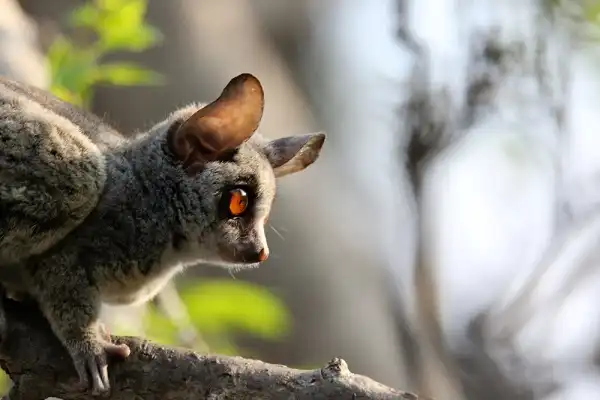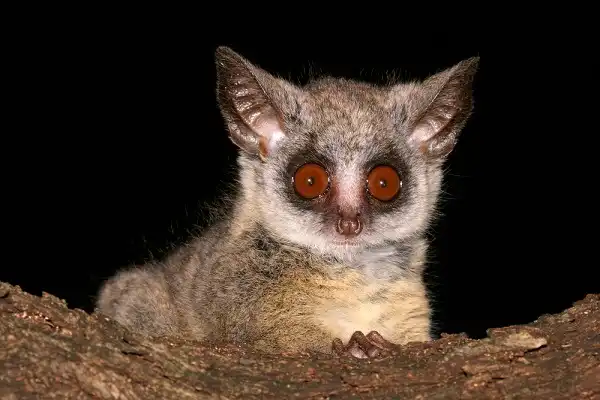Are you looking for the perfect exotic pet? Consider a bush baby! This cute, nocturnal creature is a small mammal native to Africa and parts of Asia. While owning an animal such as this can seem daunting for some, the truth is that with proper care and diet these delightful creatures are not only easy to keep but also incredibly rewarding pets. With their big eyes and expressive faces, they will quickly steal your heart away. In addition to being entertaining pets, bush babies offer many benefits including companionship, interactive playtime opportunities, and even lowered stress levels in humans. Read on to learn more about why adopting or purchasing a bush baby could be the best decision you make all year!

Bush Baby Description
A bush baby, also known as a galago, is a small, arboreal primate that belongs to the family Galagidae. These nocturnal creatures are found throughout Africa and parts of Asia, living in trees and feeding on insects, fruit, and tree sap. With their big, round eyes and iconic fur tufts on their ears, bush babies are easily recognizable and incredibly endearing to those lucky enough to encounter them in their natural habitat. Despite their diminutive size, they are incredibly agile, equipped with long, strong hind legs that allow them to leap impressive distances between branches. They have large ears that are sensitive to sound, and their eyes are adapted to see well in low-light environments, making them perfectly suited to their nocturnal lifestyle.
Bush Baby Habitat
The bush baby, also known as the galago, is a remarkable primate that calls the trees of Africa and parts of Asia it’s home. These creatures are specifically adapted to live in the arboreal environment of the forests, where they spend most of their time climbing, jumping, and leaping between branches. They are primarily nocturnal, sleeping during the day and actively foraging for food at night. Bush babies require large areas of forest to thrive, populated with trees that can provide them with adequate shelter, food, and safety. They are found in a wide range of forest habitats, including primary and secondary forests, savannah woodlands, and mountain forests. Their natural habitat is often under threat from human activities such as logging, mining, and agriculture, which can lead to population declines and endangerment. Bush babies are highly adaptable animals, capable of living in different environments and adjusting to changing conditions. They use their long hind legs to jump and climb between trees, and their long tails to maintain balance as they move. Their small size and agile physique also make it easy for them to navigate through the branches and leaves of the forest canopy.
Bush Baby Diet
Bush babies have a unique dietary requirement that is specific to their natural habitat and lifestyle. As a species that is predominately nocturnal, bush babies rely heavily on insects and other small animals as a primary source of protein. In addition to insects, they also consume fruits, vegetables, and tree gums, which help to provide them with the necessary vitamins and minerals they need to stay healthy. As pets, it is important to replicate the bush baby’s natural diet as closely as possible. Providing a varied and nutritionally balanced diet is critical to their health and well-being. Some of the recommended protein sources include mealworms, crickets, and cooked chicken or egg yolks. Fresh fruits and vegetables such as bananas, oranges, grapes, carrots, and leafy greens should also be included in their diet. Bush babies also rely heavily on water, so fresh, clean drinking water should be available at all times. Refrain from offering them bottled or stagnant water, which may contain harmful microorganisms that can cause illness. In summary, a healthy and varied diet is crucial to maintaining the health and well-being of bush babies. As an exotic pet owners, it is important to understand their unique dietary requirements and provide them with the appropriate foods that mimic their natural habitat.

Bush Baby Size
Bush babies, also known as galagos, are small primates that belong to the family Galagidae. They range in size from about 5 to 10 inches (13 to 25 centimeters) in length and weigh between 2 to 5 ounces (60-140 grams). Their size can vary depending on the species, with some being slightly larger or smaller than average. Bush babies have a striking appearance, with large, round eyes that allow them to see well in low-light conditions. Their ears are large and pointed, and they have a distinctive flattened face. Their fur is thick and woolly, providing them with insulation in cooler temperatures. Their small size allows them to move agilely through the branches of trees, making them excellent climbers and jumpers. Their long hind legs and tails give them good balance and agility, making them well-suited to life in the forest canopy.
Bush Baby Lifespan
Bush babies, also known as galagos, have a lifespan of about 10-14 years in the wild. However, their lifespan may vary depending on factors such as their diet, access to healthcare, and whether they live in captivity or in the wild. As with most animals, bush babies living in captivity tend to live longer than those in the wild due to a decreased risk of predation and access to prompt medical attention. The lifespan of a bush baby is influenced by the availability of food and water, as well as the accuracy of its senses to detect predators and navigate its environment. In captivity, providing a healthy and varied diet, access to clean water, and regular veterinary check-ups can help prolong the lifespan of these unique primates.
Bush Baby Behavior
Bush babies are fascinating creatures that exhibit complex behaviors that are unique to their species. As predominantly nocturnal animals, they spend most of their waking hours foraging for food or socializing with their kin. They are also known for their acrobatic abilities and jumping prowess, which they use to navigate the dense forest canopy. In the wild, bush babies live solitary or family-oriented lifestyles, where they bond with their kin through grooming, vocalizations, and proximity. They are territorial creatures that use scent marking to establish their territory and deter potential rivals. Despite their small size, they are also known to exhibit aggressive behaviors towards other bush babies or competing species. One of the most interesting aspects of bush baby behavior is their ability to communicate using a wide range of vocalizations. They produce a variety of sounds, from high-pitched squeaks to deep grunts, to convey different messages to their kin. These vocalizations can signal danger, express affection, or communicate their readiness to mate.

Bush Baby Speed
Bush babies, also known as galagos, are agile and nimble creatures that possess exceptional speed and agility. They are adapted to live in the forest canopy, where they can run, jump, and leap with ease. Their long hind limbs and specialized ankle bones allow them to leap distances up to 2 meters, making them some of the most acrobatic primates in the world. In addition to their impressive leaping abilities, bush babies are also incredibly fast runners. They have been observed sprinting on the forest floor at speeds of up to 22 mph, which is remarkable for an animal their size. Their long, slender bodies and powerful hind legs enable them to outrun predators and quickly move between trees to avoid danger. Their incredible speed and agility are among the reasons why they are so successful in the wild. They can quickly evade potential predators such as snakes, raptors, and small carnivores. Moreover, their nimbleness allows them to navigate through the dense forest canopy in search of food or suitable nesting sites.
Bush Baby Hunting
Bush babies, or galagos, are primarily nocturnal creatures, and their hunting habits reflect this. They are opportunistic predators, which means that they feed on whatever prey is available to them. Their diet consists mainly of insects, but they also feed on small mammals, birds, and reptiles. Due to their outstanding leaping ability and swift running speed, bush babies can pursue and capture fast-moving prey with ease. They use their sharp claws and teeth to catch insects, and their powerful jaws to dispatch small animals. Interestingly, bush babies are also known to engage in cooperative hunting, where they work together to capture larger prey. For instance, they have been observed to team up to catch a small bird or bat by coordinating their movements and using their combined speed and agility to corner and capture their target. While hunting, bush babies use several techniques to track their prey, including scent marking and visual cues. They also use their acute senses and well-developed communication skills to coordinate their movements and stalk their prey efficiently.
Bush Baby Reproduction
In addition to hunting, bush babies also reproduce in order to ensure the survival of their species. Female bush babies reach sexual maturity at around 10 months of age, while males reach sexual maturity at around 15 months. Most mating occurs between mid-August and mid-February, which is when female bush babies are most receptive to mating. Bush baby females usually have one litter per year that can consist of up to 4 offspring. After a gestation period of about 2 months, the female will give birth in a nest or den that she has built off the ground. The young are born blind and helpless and weigh less than an ounce at birth. The mother will nurse her offspring for up to 5 weeks before they become self-sufficient enough to leave the den.

Bush Baby Interactions with Humans
Bush babies are generally shy creatures and will usually avoid contact with humans whenever possible. However, there have been instances of bush babies being kept as pets or used for entertainment purposes. Unfortunately, this has contributed to the decline in wild populations of some species, as many pet owners do not understand the needs of their animals or how to care for them properly. In addition, bush babies may be hunted by humans for food or sport in certain areas. As bush babies are an important part of the forest ecosystem, hunting them can have a detrimental effect on their population and the environment they inhabit. Therefore, it is important that hunters take proper precautions when hunting these animals to ensure that their numbers remain healthy and stable.
Conclusion
Bush babies are remarkable creatures with a wide range of adaptations that allow them to survive in their natural habitat. Their impressive leaping abilities and swift running speed enable them to outrun predators, while their acute senses and communication skills aid them in hunting efficiently. Furthermore, they play a vital role in maintaining the balance of the forest ecosystem by controlling the population of insects and small animals. Understanding and appreciating these incredible creatures is essential for promoting their well-being and ensuring their continued existence in the wild.
Frequently Asked Question


